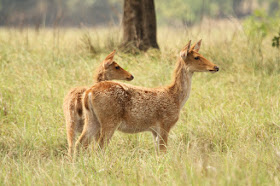This visit to Bandhavgarh was the second part of a one-week tour to Kanha and Bandhavgarh National Parks. This was also my second visit to this park, having been here once before in March 2013. With about 60 tigers in a core reserve area of approximately 105 square kilometers, Bandhavgarh National Park is said to have the highest density of tigers in India, and enjoys a reputation among tourists as providing the best probabilities of spotting a tiger in the wild. Besides the tigers, there are many other species of animals to be seen and some very impressive vistas, such as the Tala Hills shown in the photo below. But without question, the big attraction that draws visitors here is the chance to meet a tiger at close range.
In tourist circles, the Tala zone was long reputed to be the best for spotting tigers, and prices for safaris in this zone are higher than prices for the other two zones. According to information on one homepage (information on different pages vary widely), present prices for entry (entry ticket and jeep fee) into Bandhavgarh National Park appear to be 7,400 rupees for foreigners and 5,000 rupees for Indian nationals for the premium Tala zone; and 5,000 rupees for foreigners and 3,800 rupees for Indian nationals for the Magadhi and Khitauli zones. Like in Kanha, visitors should also be prepared to pay a fee for a park-assigned guide (300 rupees), and it is customary to tip both the driver and guide after each safari.
Ironically, although Tala is the “premium” zone, it appears that the larger number of tiger sightings this year are occurring in the other zones. Staff at the hotel and guides in the park explained to us that there was a fight for territory going on between three male tigers, and that the female tigers resident in the Tala zone were hiding their young cubs from the adult males. This occurs because male tigers will kill cubs conceived by other males in other to coax the females back into mating readiness. The males apparently do this in order to leave more of their DNA in the next generation of tigers.
Since the travel company had arranged
for all four of our group’s safaris to be in the more expensive “premium” Tala
zone in order to increase our chances of seeing tigers, under the current
conditions this move had the opposite effect. As a result, the members on our tour did not
see any tigers at all in Bandhavgarh.
Although I was unable to see any tigers
on this trip to Bandhavgarh, here are photos of the animals that I was able to
spot.
Chital
deer (Cervus axis)
A group of chital near a waterhole.
Indian
gray mongoose
Rhesus
macaque
Indian Roller
Crested
serpent eagle
Hanuman Langur
Wild pig
Kingfisher
Indian
Vultures
Jackal
Indian Nightjar
Gaur
Sadly, there are no remaining wild elephants in Bandhavgarh National Park. All of the elephants that are in the park belong to mahouts who train the animals to serve as transportation for patrols and to do other work within the national park. It was a little sad to see some young elephants with their legs chained to the older elephants in order to “train” them.
Sometimes the elephants were allowed to greet visitors. For visitors who had failed to spot a tiger, this chance to engage with an elephant went a long way towards soothing the disappointment.
After two days and four safaris with no tigers, at least our guides were able to show us this beautiful sunset over the Bandhavgarh hills.
It was a gentle and beautiful way to end this one-week trip looking for tigers, but still, I somehow felt that something was incomplete. I guess I will have to return again someday.
(Note:
All photos taken in this post were taken during a visit from May 7 to May 8,
2015. The comments in this post are
based on observations made on those days.
Conditions may have since changed.
Please check it out for yourself!)




































